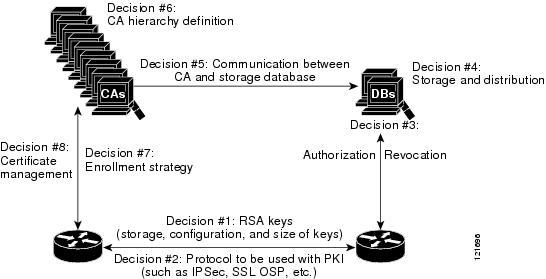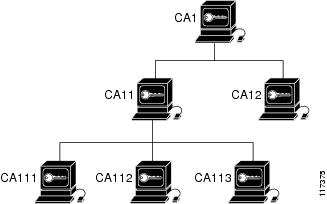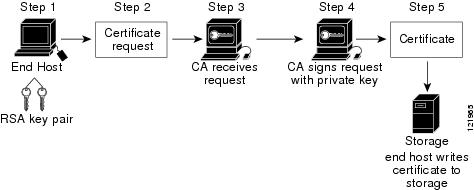

Contents
- Cisco IOS PKI Overview Understanding and Planning a PKI
- Finding Feature Information
- Information About Cisco IOS PKI
- What Is Cisco IOS PKI
- RSA Keys Overview
- What Are CAs
- Hierarchical PKI Multiple CAs
- When to Use Multiple CAs
- Certificate Enrollment How It Works
- Certificate Enrollment Via Secure Device Provisioning
- Certificate Revocation Why It Occurs
- Planning for a PKI
- Where to Go Next
- Additional References
- Glossary
Cisco IOS PKI Overview Understanding and Planning a PKI
Cisco IOS public key infrastructure (PKI) provides certificate management to support security protocols such as IP Security (IPSec), secure shell (SSH), and secure socket layer (SSL). This module identifies and describes concepts that are needed to understand, plan for, and implement a PKI.
Finding Feature Information
Your software release may not support all the features documented in this module. For the latest caveats and feature information, see Bug Search Tool and the release notes for your platform and software release. To find information about the features documented in this module, and to see a list of the releases in which each feature is supported, see the feature information table at the end of this module.
Use Cisco Feature Navigator to find information about platform support and Cisco software image support. To access Cisco Feature Navigator, go to www.cisco.com/go/cfn. An account on Cisco.com is not required.
Information About Cisco IOS PKI
- What Is Cisco IOS PKI
- RSA Keys Overview
- What Are CAs
- Certificate Enrollment How It Works
- Certificate Revocation Why It Occurs
What Is Cisco IOS PKI
A PKI is composed of the following entities:
- Peers communicating on a secure network
- At least one certification authority (CA) that grants and maintains certificates
- Digital certificates, which contain information such as the certificate validity period, peer identity information, encryptions keys that are used for secure communications, and the signature of the issuing CA
- An optional registration authority (RA) to offload the CA by processing enrollment requests
- A distribution mechanism (such as Lightweight Directory Access Protocol [LDAP] or HTTP) for certificate revocation lists (CRLs)
PKI provides customers with a scalable, secure mechanism for distributing, managing, and revoking encryption and identity information in a secured data network. Every entity (a person or a device) participating in the secured communicated is enrolled in the PKI in a process where the entity generates an Rivest, Shamir, and Adelman (RSA) key pair (one private key and one public key) and has their identity validated by a trusted entity (also known as a CA or trustpoint).
After each entity enrolls in a PKI, every peer (also known as an end host) in a PKI is granted a digital certificate that has been issued by a CA. When peers must negotiate a secured communication session, they exchange digital certificates. Based on the information in the certificate, a peer can validate the identity of another peer and establish an encrypted session with the public keys contained in the certificate.
Although you can plan for and set up your PKI in a number of different ways, the figure below shows the major components that make up a PKI and suggests an order in which each decision within a PKI can be made. The figure is a suggested approach; you can choose to set up your PKI from a different perspective.
RSA Keys Overview
An RSA key pair consists of a public key and a private key. When setting up your PKI, you must include the public key in the certificate enrollment request. After the certificate has been granted, the public key will be included in the certificate so that peers can use it to encrypt data that is sent to the router. The private key is kept on the router and used both to decrypt the data sent by peers and to digitally sign transactions when negotiating with peers.
RSA key pairs contain a key modulus value. The modulus determines the size of the RSA key. The larger the modulus, the more secure the RSA key. However, keys with large modulus values take longer to generate, and encryption and decryption operations take longer with larger keys.
What Are CAs
A CA, also known as a trustpoint, manages certificate requests and issues certificates to participating network devices. These services (managing certificate requests and issuing certificates) provide centralized key management for the participating devices and are explicitly trusted by the receiver to validate identities and to create digital certificates. Before any PKI operations can begin, the CA generates its own public key pair and creates a self-signed CA certificate; thereafter, the CA can sign certificate requests and begin peer enrollment for the PKI.
You can use a CA provided by a third-party CA vendor, or you can use an "internal" CA, which is the Cisco IOS Certificate Server.
Hierarchical PKI Multiple CAs
PKI can be set up in a hierarchical framework to support multiple CAs. At the top of the hierarchy is a root CA, which holds a self-signed certificate. The trust within the entire hierarchy is derived from the RSA key pair of the root CA. The subordinate CAs within the hierarchy can be enrolled with either the root CA or with another subordinate CA. These enrollment options are how multiple tiers of CAs are configured. Within a hierarchical PKI, all enrolled peers, can validate the certificate of one another if the peers share a trusted root CA certificate or a common subordinate CA.
The figure below shows the enrollment relationships among CAs within a three-tiered hierarchy.
Each CA corresponds to a trustpoint. For example, CA11 and CA12 are subordinate CAs, holding CA certificates that have been issued by CA1; CA111, CA112, and CA113 are also subordinate CAs, but their CA certificates have been issued by CA11.
When to Use Multiple CAs
Multiple CAs provide users with added flexibility and reliability. For example, subordinate CAs can be placed in branch offices while the root CA is at the office headquarters. Also, different granting policies can be implemented per CA, so you can set up one CA to automatically grant certificate requests while another CA within the hierarchy requires each certificate request to be manually granted.
Scenarios in which at least a two-tier CA is recommended are as follows:
- Large and very active networks in which a large number of certificates are revoked and reissued. A multiple tier CA helps to control the size of the CRLs.
- When online enrollment protocols are used, the root CA can be kept offline with the exception of issuing subordinate CA certificates. This scenario provides added security for the root CA.
Certificate Enrollment How It Works
Certificate enrollment is the process of obtaining a certificate from a CA. Each end host that wants to participate in the PKI must obtain a certificate. Certificate enrollment occurs between the end host requesting the certificate and the CA. The figure below and the following steps describe the certificate enrollment process.
- The end host generates an RSA key pair.
- The end host generates a certificate request and forwards it to the CA (or the RA, if applicable).
- The CA receives the certificate enrollment request, and, depending on your network configuration, one of the following options occurs:
 Note | If you configure the end host to automatically request certificates from the CA, you should have an additional authorization mechanism. |
Certificate Enrollment Via Secure Device Provisioning
Secure Device Provisioning (SDP) is a web-based certificate enrollment interface that can be used to easily deploy PKI between two end devices, such as a Cisco IOS client and a Cisco IOS certificate server.
SDP (also refer red to as Trusted Transitive Introduction [TTI]) is a communication protocol that provides a bidirectional introduction between two end entities, such as a new network device and a Virtual Private Network (VPN). SDP involves the following three entities:
- Introducer--A mutually trusted device that introduces the petitioner to the registrar. The introducer can be a device user, such as a system administrator.
- Petitioner--A new device that is joined to the secure domain.
- Registrar--A certificate server or other server that authorizes the petitioner.
SDP is implemented over a web browser in three phases--welcome, introduction, and completion. Each phase is shown to the user via a web page. For more information on each phase and how SDP works, see the "Setting Up Secure Device Provisioning (SDP) for Enrollment in a PKI" module.
Certificate Revocation Why It Occurs
After each participant has successfully enrolled in the PKI, the peers are ready to begin negotiations for a secure connection with each other. Thus, the peers present their certificates for validation followed by a revocation check. After the peer verifies that the other peer's certificate was issued by an authenticated CA, the CRL or Online Certificate Status Protocol (OCSP) server is checked to ensure that the certificate has not been revoked by the issuing CA. The certificate usually contains a certificate distribution point (CDP) in the form of a URL. Cisco IOS software uses the CDP to locate and retrieve the CRL. If the CDP server does not respond, the Cisco IOS software reports an error, which may result in the peer's certificate being rejected.
Planning for a PKI
Planning for a PKI requires evaluating the requirements and expected use for each of the PKI components shown in Planning for a PKI. It is recommended that you (or the network administrator) thoroughly plan the PKI before beginning any PKI configuration.
Although there are a number of approaches to consider when planning the PKI, this document begins with peer-to-peer communication and proceeds as shown in Planning for a PKI. However you or the network administrator choose to plan the PKI, understand that certain decisions influence other decisions within the PKI. For example, the enrollment and deployment strategy could influence the planned CA hierarchy. Thus, it is important to understand how each component functions within the PKI and how certain component options are dependent upon decisions made earlier in the planning process.
Where to Go Next
As suggested in Where to Go Next, you begin to configure a PKI by setting up and deploying RSA keys. For more information, see the module "Deploying RSA Keys Within a PKI."
Additional References
Related Documents
|
Related Topic |
Document Title |
|---|---|
|
PKI commands: complete command syntax, command mode, defaults, usage guidelines, and examples |
Cisco IOS Security Command Reference |
|
Certificate enrollment: supported methods, enrollment profiles, configuration tasks |
Configuring Certificate Enrollment for a PKI module in the Cisco IOS Security Configuration Guide: Secure Connectivity |
|
Certificate revocation and authorization: configuration tasks |
Configuring Revocation and Authorization of Certificates in a PKI module in the Cisco IOS Security Configuration Guide: Secure Connectivity |
|
Cisco IOS certificate server overview information and configuration tasks |
Configuring and Managing a Cisco IOS Certificate Server for PKI Deployment module in the Cisco IOS Security Configuration Guide: Secure Connectivity |
|
Secure Device Provisioning: functionality overview and configuration tasks |
Setting Up Secure Device Provisioning (SDP) for Enrollment in a PKI module in the Cisco IOS Security Configuration Guide: Secure Connectivity |
|
Storing RSA keys and certificates on a USB eToken |
Storing PKI Credentials module in the Cisco IOS Security Configuration Guide: Secure Connectivity |
MIBs
RFCs
|
RFCs |
Title |
|---|---|
|
RFC 2459 |
http://www.ietf.org/rfc/rfc2459.txtInternet X.509 Public Key Infrastructure Certificate and CRL Profile |
|
RFC 2511 |
http://www.ietf.org/rfc/rfc2511.txtInternet X.509 Certificate Request Message Format |
|
RFC 2527 |
http://www.ietf.org/rfc/rfc2527.txt Internet X.509 Public Key Infrastructure Certificate Policy and Certification Practices Framework |
|
RFC 2528 |
http://www.ietf.org/rfc/rfc2528.txtInternet X.509 Public Key Infrastructure |
|
RFC 2559 |
http://www.ietf.org/rfc/rfc2559.txtInternet X.509 Public Key Infrastructure Operational Protocols - LDAPv2 |
|
RFC 2560 |
http://www.ietf.org/rfc/rfc2560.txtX.509 Internet Public Key Infrastructure Online Certificate Status Protocol - OCSP |
|
RFC 2585 |
http://www.ietf.org/rfc/rfc2585.txtInternet X.509 Public Key Infrastructure Operational Protocols: FTP and HTTP |
|
RFC 2587 |
http://www.ietf.org/rfc/rfc2587.txtInternet X.509 Public Key Infrastructure LDAPv2 Schema |
|
RFC 2875 |
http://www.ietf.org/rfc/rfc2875.txtDiffie-Hellman Proof-of-Possession Algorithms |
|
RFC 3029 |
http://www.ietf.org/rfc/rfc3029.txtInternet X.509 Public Key Infrastructure Data Validation and Certification Server Protocols |
Technical Assistance
|
Description |
Link |
|---|---|
|
The Cisco Support and Documentation website provides online resources to download documentation, software, and tools. Use these resources to install and configure the software and to troubleshoot and resolve technical issues with Cisco products and technologies. Access to most tools on the Cisco Support and Documentation website requires a Cisco.com user ID and password. |
Glossary
CDP --certificate distribution point. Field within a digital certificate containing information that describes how to retrieve the CRL for the certificate. The most common CDPs are HTTP and LDAP URLs. A CDP may also contain other types of URLs or an LDAP directory specification. Each CDP contains one URL or directory specification.
certificates --Electronic documents that bind a user's or device's name to its public key. Certificates are commonly used to validate a digital signature.
CRL --certificate revocation list. Electronic document that contains a list of revoked certificates. The CRL is created and digitally signed by the CA that originally issued the certificates. The CRL contains dates for when the certificate was issued and when it expires. A new CRL is issued when the current CRL expires.
CA --certification authority. Service responsible for managing certificate requests and issuing certificates to participating IPSec network devices. This service provides centralized key management for the participating devices and is explicitly trusted by the receiver to validate identities and to create digital certificates.
peer certificate --Certificate presented by a peer, which contains the peer's public key and is signed by the trustpoint CA.
PKI --public key infrastructure. System that manages encryption keys and identity information for components of a network that participate in secured communications.
RA --registration authority. Server that acts as a proxy for the CA so that CA functions can continue when the CA is offline. Although the RA is often part of the CA server, the RA could also be an additional application, requiring an additional device to run it.
RSA keys --Public key cryptographic system developed by Ron Rivest, Adi Shamir, and Leonard Adleman. An RSA key pair (a public and a private key) is required before you can obtain a certificate for your router.
Cisco and the Cisco logo are trademarks or registered trademarks of Cisco and/or its affiliates in the U.S. and other countries. To view a list of Cisco trademarks, go to this URL: www.cisco.com/go/trademarks. Third-party trademarks mentioned are the property of their respective owners. The use of the word partner does not imply a partnership relationship between Cisco and any other company. (1110R)
Any Internet Protocol (IP) addresses and phone numbers used in this document are not intended to be actual addresses and phone numbers. Any examples, command display output, network topology diagrams, and other figures included in the document are shown for illustrative purposes only. Any use of actual IP addresses or phone numbers in illustrative content is unintentional and coincidental.

 Feedback
Feedback

